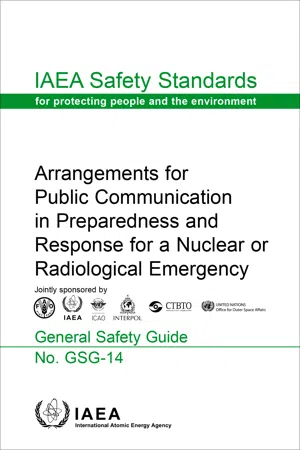1. INTRODUCTION
Background
1.1. Jointly sponsored by 13 international organizations, IAEA Safety Standards Series No. GSR Part 7, Preparedness and Response for a Nuclear or Radiological Emergency [1], establishes the requirements for an adequate level of preparedness and response for a nuclear or radiological emergency, irrespective of the initiator of the emergency, which could be a natural event, a human error, a mechanical or other failure, or a nuclear security event.
1.2. Requirement 10 of GSR Part 7 [1] states:
“The government shall ensure that arrangements are in place to provide the public who are affected or are potentially affected by a nuclear or radiological emergency with information that is necessary for their protection, to warn them promptly and to instruct them on actions to be taken.”
1.3. IAEA Safety Standards Series No. GSR Part 3, Radiation Protection and Safety of Radiation Sources: International Basic Safety Standards [2], establishes requirements for the protection of people and the environment from harmful effects of ionizing radiation in all situations of exposure, including in emergency exposure situations. Requirement 43 of GSR Part 3 [2] requires the establishment of an emergency management system. Furthermore, para. 4.5(e) of GSR Part 3 [2] states:
“The emergency management system shall provide for essential elements at the scene, and at the local, national and international level, as appropriate, including…:
(e) Reliable communication, including public information”.
1.4. Requirement 13 of GSR Part 7 [1] states:
“The government shall ensure that arrangements are in place for communication with the public throughout a nuclear or radiological emergency.”
1.5. Public communication is essential to the effectiveness of protective actions to mitigate adverse consequences of an emergency for human life, health, property and the environment. Effective communication with the public that is timely, clear and accurate is also important for maintaining trust on the part of the public (hereafter referred to as ‘public trust’). Experience has demonstrated the importance of, and the challenges involved in, communicating with the public in a nuclear or radiological emergency. Past emergencies have had local, national, regional and international consequences and have led to high levels of public awareness and concern. This has led to greater emphasis being placed on effective public communication in preparedness and response for a nuclear or radiological emergency.
1.6. Effective public communication is dependent on the level of emergency preparedness of the States and organizations involved. Emergency preparedness includes developing a public communication programme, including a strategy and plans for being adequately prepared for public communication in a nuclear or radiological emergency.
1.7. In meeting Requirements 10 and 13 of GSR Part 7 [1], States will contribute to fulfilling, in part, Requirement 16 of GSR Part 7 [1], which states:
“The government shall ensure that arrangements are in place for mitigation of non-radiological consequences of a nuclear or radiological emergency and of an emergency response.”
Such non-radiological consequences could include, for example, anxiety and long term psychological effects among the public. These non-radiological consequences could be mitigated by means of effective public communication on radiological health hazards and clear instructions on any protective actions to be taken.
Objective
1.8. The objective of this Safety Guide is to provide recommendations on meeting requirements relating to arrangements for public communication in preparedness and response for a nuclear or radiological emergency. The main requirements are Requirements 10, 13 and 16 of GSR Part 7 [1]. Requirement 43 of GSR Part 3 [2] on the emergency management system is also relevant.
1.9. This Safety Guide provides recommendations to States on arrangements to be made at the preparedness stage for communication with the public and the news media for the purpose of mitigating adverse consequences of a nuclear or radiological emergency for human life, health, property and the environment. It provides recommendations and guidance for ensuring that due attention is paid to public communication in preparedness and response for an emergency and for supporting decisions made on protective actions. This Safety Guide also provides recommendations on activating these arrangements in an emergency response. It further provides recommendations on the coordination of response organizations and other authorities providing official information in preparedness and response for a nuclear or radiological emergency.
1.10. The recommendations provided in this Safety Guide are also intended to help to reduce anxiety among the public and to reduce the likelihood of actions being ...
